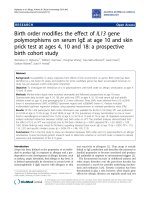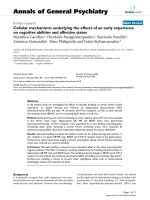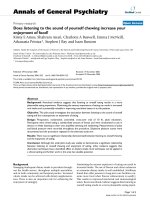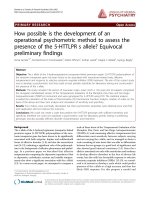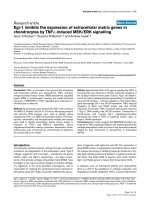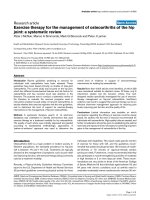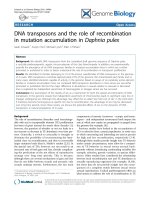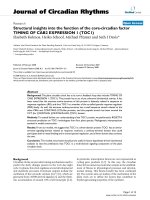Báo cáo y học: "Ischemic preconditioning reduces the severity of ischemia-reperfusion injury of peripheral nerve in rat" pptx
Bạn đang xem bản rút gọn của tài liệu. Xem và tải ngay bản đầy đủ của tài liệu tại đây (439.3 KB, 5 trang )
BioMed Central
Page 1 of 5
(page number not for citation purposes)
Journal of Brachial Plexus and
Peripheral Nerve Injury
Open Access
Research article
Ischemic preconditioning reduces the severity of
ischemia-reperfusion injury of peripheral nerve in rats
Yusuf Kenan Coban*
1
, Harun Ciralik
2
and Ergul Belge Kurutas
3
Address:
1
Dept. Of Plastic Surgery, Sutcuimam University, School of Medicine, Kahramanmaras¸, Turkey,
2
Dept. Of Pathology, Sutcuimam
University, School of Medicine, Kahramanmaras¸, Turkey and
3
Dept. Of Biochemistry, Sutcuimam University, School of Medicine,
Kahramanmaras¸, Turkey
Email: Yusuf Kenan Coban* - ; Harun Ciralik - ; Ergul Belge Kurutas -
* Corresponding author
Abstract
Background and aim: Allow for protection of briefly ischemic tissues against the harmful effects
of subsequent prolonged ischemia is a phenomennon called as Ischemic Preconditioning (IP). IP has
not been studied in ischemia-reperfusion (I/R) model of peripheral nerve before. We aimed to
study the effects of acute IP on I/R injury of peripheral nerve in rats.
Method: 70 adult male rats were randomly divided into 5 groups in part 1 experimentation and 3
groups in part 2 experimentation. A rat model of severe nerve ischemia which was produced by
tying iliac arteries and all idenfiable anastomotic vessels with a silk suture (6-0) was used to study
the effects of I/R and IP on nerve biochemistry. The suture technique used was a slip-knot
technique for rapid release at time of reperfusion in the study. Cytoplasmic vacuolar degeneration
was also histopathologically evaluated by light microscopic examination in sciatic nerves of rats at
7th day in part 2 study.
Results: 3 hours of Reperfusion resulted in an increase in nerve malondialdehyde levels when
compared with ischemia and non-ischemia groups (p < 0.001 and p < 0.0001 respectively). IP had
significantly lower nerve MDA levels than 3 h reperfusion group (p < 0.001). The differences
between ischemic, IP and non-ischemic control groups were not significant (p > 0.05). There was
also a significant decrease in vacoular degeneration of sciatic nerves in IP group than I/R group (p
< 0.05).
Conclusion: IP reduces the severity of I/R injury in peripheral nerve as shown by reduced tissue
MDA levels at 3 th hour of reperfusion and axonal vacoulization at 7 th postischemic day.
Background
Ischemia-reperfusion (I/R) causes oxidative injury and
ischemic fiber degeneration (IFD), due to injury of the
neuron and axon, after enough ischemic times, i.e.4–5
hours of peripheral nerve ischemia [1,2]. Maximal inter-
cellular adhesion molecule-1 (ICAM-1) expression on
endoneural vessels and polymorphonuclear monocytes
reaches a peak at 24 th hour and macrophages increases
nearly four fold at 48–72 hour of reperfusion after a 5 h of
near-complete ischemia [3]. All these cells are responsible
for demyelinisation and IFD at prolonged reperfusion
after enough ischemic times in peripheral nerves [4,5].
Nerve lipid hydroperoxides reaches greatest levels at 3
hour and a gradual decline follows over the next month
Published: 29 September 2006
Journal of Brachial Plexus and Peripheral Nerve Injury 2006, 1:2 doi:10.1186/1749-7221-1-2
Received: 20 February 2006
Accepted: 29 September 2006
This article is available from: />© 2006 Coban et al; licensee BioMed Central Ltd.
This is an Open Access article distributed under the terms of the Creative Commons Attribution License ( />),
which permits unrestricted use, distribution, and reproduction in any medium, provided the original work is properly cited.
Journal of Brachial Plexus and Peripheral Nerve Injury 2006, 1:2 />Page 2 of 5
(page number not for citation purposes)
with reperfusion [6]. An aggrevated reperfusion injury in
Streptozocine induced diabetic rats could be seen with
less severe ischemic times [7]. Clinical experience related
to I/R injury of peripheral nerve shows that neurologic
recovery is possible, if reperfusion starts within 6 hours
after ischemia [8].
Allow for protection of briefly ischemic tissues against the
harmful effects of subsequent prolonged ischemia is a
phenomennon called as Ischemic Preconditioning
(IP)[9]. There are two distinct types of protection afforded
by this adaptational reponse, i.e. acute and delayed pre-
conditioning. The factors that initiate the acute and
delayed preconditioning responses appear to be similiar.
However, the protective effects of acute preconditioning
are protein synthesis independent, while the effects of
delayed preconditioning require protein synthesis. Adap-
tational responses to I/R injury have been demonstrated
in different tissue types [10-14]. IP has not been studied
in I/R model of peripheral nerve before. We aimed to
study the effects of acute IP on I/R injury of peripheral
nerve in rats.
Materials and methods
Animals
All animals were obtained from Experimental Research
Laboratory of Sutcuimam University School of Medicine.
The experimental design was approved by the Ethical
commite of KSU. 200–250 g adult male spraque-dawley
rats were used in the study. The animals were fed with
standart rats diets until the surgical procedures.
We examined I/R induced pathological and biochemical
changes along the lenght of scaitic nerve. Major arteries
which supply rat hindlimb were occluded for 4 hours.
Reperfusion was accomplished by the release of ties of
abdominal aorta and its branches. Nerve pathology and
biochemical analysis in sciatic nerve samples of the rats
were assesed after 3 hours and 7 days of reperfusion. A
total of 70 rats were used in the study. The study was
divided into two part. Part 1 included the biochemical
examination of Ischemia, I/R and I/R+IP on sciatic nerves
of rats at the early period. Part 2 which consisted of 3
groups aimed to evaluate the histopathological changes in
the nerves 7 days after the experimentation. The rats were
randomly divided into following groups, 7 rats in each;
Part 1:Short time effects of I/R and IP
Group I- Normal adult male rats (Non-isch): Non-
ischemic group, no intervention was made, simply sciatic
nerve samples were taken.
Group II- Ischemic group (Ischemic control-0hR): 4
hours of limb ischemia were done and the samples were
taken from the sciatic nerves after ischemic insult.
Group III- Ischemia-reperfusion group (3hR): 4 hours of
ischemia and following 3 hours of reperfusion were done.
After I/R of sciatic nerves samples were taken.
Group IV- I/R plus ischemic preconditioning group
(3hR+IP): Preconditioning (three cycles of 5 minutes of
short ischemia with 2 minute's intervals), and then 4
hours of ischemia with 3 hours of reperfusion.
Part 2: Long time effetcs of I/R and IP
Group 1- I/R with long duration (7dR):4 hours of
ischemia and 7 days of reperfusion.
Group 2- Preconditioning plus I/R with long duration
(7dR+IP): The same preconditioning protocol with the
group IV, and then, 4 hours of ischemia with following 7
days of reperfusion. In both groups, sciatic nerve samples
taken from both limb at 7th day were examined his-
topathologically.
Group 3- Sham operated group: Abdominal aorta and its
collaterals were simply exposed under anesthesia, but no
intervention was done. Then abdominal incision was pri-
marly closed. At 7th day, sciatic nerve samples were taken
as done in the other groups.
Model of severe nerve ischemia
Our model of severe nerve ischemia was produced by
tying of the iliolumbar and inferior mesenteric arteries
followed by the temporary occlusion of the abdominal
aorta and both iliac arteries [15]. We tied off all identifia-
ble anastomotic vessels, including the iliolumbar and
inferior mesenteric arteries. The aorta and iliac arteries
were tied with a silk suture (6-0), using a slip-knot tech-
nique for rapid release, when needed. Measurements of
the femoral blood pressure (BP) were used to monitor the
completeness of the occlusion, and direct inspection of
the sciatic nerve epineurial vessels showed that blood flow
had been arrested. Sluggish flow was sometimes seen in
these vessels several minutes after aortic occlusion, pre-
sumably due to partial reestablishment of anastomotic
flow.
Ischemia-reperfusion and ischemic preconditioning model
The rat was anesthetized with intraperitoneal pentobarbi-
tal (60 mg/kg) followed by surgery to produce IR.
Ischemia was produced by ligating the abdominal aorta,
the right iliac artery, the right femoral artery, and all iden-
tifiable collateral vessels supplying the sciatic nerves with
6-0 silk sutures. After 3 h of ischemia at 35°C, the ties
were released using a slipknot technique for ready release
and rapid reperfusion [16]. This procedure was done in IP
groups for 3 times before the prolonged ischemia. Sciatic
nerves were harvested at 3 hours and 1 week after
Journal of Brachial Plexus and Peripheral Nerve Injury 2006, 1:2 />Page 3 of 5
(page number not for citation purposes)
ischemia surgery for the MDA measurements and his-
topathological studies, respectively.
Neuropathology: edema and axonal vacoulisation
A sciatic nerve segment at 2 cm long was harvested from
each animal. The sciatic nerves were osmicated, dehy-
drated, infiltrated, and embedded in Spurr's resin. Longiti-
dunal sections of 1.0 cm were stained with hematoxylen
eozine. Under 40× magnification, these sections were
graded for edema and axonal vacoulisation using previ-
ously described methods [17]. The axon may be swollen
or shrunken, watery and light, or dark and shrunken. Sec-
ondary myelin changes were typically seen, including
attenuation, collapse, or break-down. For each section,
the vacoulisation and edema were semi-quantitatively
graded from 0 to 3 as follows: 0-normal, 1-mild, 2-mod-
erate and 3-severe. No distinction was made as to endone-
urial, perivascular, or subperineurial edema. A mean value
for each rat was calculated after examination of four sec-
tions represented that case.
Statistics
The values were expressed as mean ± standart of deviation.
The differences between the groups were analysed by
using ANOVA. Non-parametric data was evaluated by
Mann Whithney-U test. A p value less than 0.05 was con-
sidered as significant.
Results
MDA levels in sciatic nerve
During the occlusion of aorta and iliac arteries, the meas-
urements of femoral blood pressure aproximated to zero
values in rats of all the groups.
The MDA levels of nerve tissue segments in different
groups and nerve vacuolisation degrees is shown in the
table 1. Ischemic preconditioning group had significantly
lower nerve MDA levels than reperfusion group (p <
0.001). The differences between ischemic, IP and non-
ischemic control groups were not significant (p > 0.05),
(figure 1).
Histopathologic changes
Great cytoplasmic vacoulisation caused by proliferation
and dilation of the rough and smooth endoplasmic retic-
ulum and golgi apparatus was observed in I/R and IP
groups of part 2 experimentation. The intramyelinic
edema within nerve fibers was seen not only in perivascu-
lar region, but also, in endoneurial vessels (Figures 2, 3
and 4). IP group had a significantly good histopathologic
score than I/R group (p < 0.05). Table 1 shows the scores
in the groups.
Discussion
Nerve pathology in acute ischemic injury has beeen delin-
eated in peripheral nerve and reperfusion injury could
amplify ischemic pathology. Nerve ischemia plays a major
role in the development of pathological alteration in var-
ous neuropathies and the effects of ischemia are amplified
by reperfusion in various tissues. In nerve tissue, two types
of edema is described after I/R; endoneural edema and
intramyelinic edema [17]. Endoneural edema reflects in
blood-nerve barrier and possibly reflects endoneural
events especially severity of IFD. Myelin appears to be par-
ticularly susceptible to activated free radicals, activated
neutrophils and cytokine formation. Severe ischemia to
nerve results in energy rundown followed by conduction
failure and fiber degeneration. Inflammatory responses to
IR have not only been confined to a few days (up to 7–14
Sciatic nerve MDA (nmol/mg protein) levels in groupsFigure 1
Sciatic nerve MDA (nmol/mg protein) levels in groups.
(1.00:non-ischemic controls, 2.00:ischemic preconditioning,
3.00:ischemia-3 h reperfusion, 4.00:ischemia only). Bars show
means. Error bars show 95.0% CI of means.
Table 1: Non-parametric evaluation scores in part 2
experimentation.
Parameter I/R IP Sham
Edema 32*0**
Vacoulisation 210
The scale for the evaluated parameters as follows: normal-0, mild-1,
moderate-2, severe-3 for endoneurial edema;no vacoulisation-0, mild
vacoulisation-1, massive vacoulisation-2 for axonal vacuolisation.(* p <
0.05 for I/R versus IP, **p < 0.00001 for I/R versus IP).
Journal of Brachial Plexus and Peripheral Nerve Injury 2006, 1:2 />Page 4 of 5
(page number not for citation purposes)
days) of reperfusion, but also much more extended time
(up to 42 days) of reperfusion [18]. Between 7 days and
14 days of reperfusion, the IFD was reported to be the
most prominent. Morphological changes of IFD at the
light microscopic level occur in concert with endoneurial
edema at the 7 and 14 day reperfusion time-points. I/R
injury of sciatic nerve has been shown to increase proin-
lammatory cytokines which are primarly responsible
demyelinization after reperfusion in peripheral nerves
[19]. Another important indicator of I/R injury of periph-
eral nerve is Nitric Oxide products which were found as
increased at the first 24 hours of reperfusion in nerve tis-
sue and their elevation has been reported to play an essen-
tial role in reducing the severity of the I/R injury by
inhibiting neutrophil adhesion in postcapillary venules
and by decreasing microvascular constriction [20]. In our
study, axonal changes at 7 th day were evaluated. It has
been seen that IP treated group showed less cytoplasmic
vacuolisation and edema formation than I/R group (p <
0.05). This finding was concominant to the finding of
decreased oxidative injury (i.e. decreased MDA levels in
nerve tissue) seen in IP pretreated group.
Previously protective effects of IP in intestine, liver, myo-
card, skeletal muscle and pancreas tissues has been shown
[10-14,21,22]. What play role in the protective effect of IP
is not exactly known, but some putative mechanims,
which are mostly dealed with countering the proinflam-
matory and proapoptotic effects generated during IR have
been put forward [23]. IP has been shown to decrease the
formation of hydroxyl radicals during reperfusion [24]. A
reduced TNF-alpha and ICAM-1 mRNA expression seen
after IP may account for the inhibitory effects of IP on leu-
kocyte adhesion and ameloriated microcirculatory distur-
bance after IR in vivo [23-26].
The protective effects of IP against lesions caused by sub-
sequent severe ischemia was primarly described in the
heart by Murry et al [9]. Increased antioxidant enzyme
activities which may be an indirect indicator of the
reduced injury after I/R has been shown in brain ischemic
tolerance by IP [27]. However to best of our knowledge,
nobody has studied this phenomennon in peripheral
somatic nerve. The benefical effect of IP in rat sciatic nerve
was manifested by a reduction in MDA tissue levels at 3th
Mild vacuolisation in axons of sciatic nerve (ischemic precon-ditioning group, score 2), Hematoxylen esozine 40× magnifi-cationFigure 4
Mild vacuolisation in axons of sciatic nerve (ischemic precon-
ditioning group, score 2), Hematoxylen esozine 40× magnifi-
cation.
Normal architechture of sciatic nerve of rat is seen (sham group), Hematoxylen esozine 40× magnificationFigure 2
Normal architechture of sciatic nerve of rat is seen (sham
group), Hematoxylen esozine 40× magnification.
Increased axonal vacuolisation degeneration is seen at longiti-dunal section of sciatic nerve (I/R group, score 3), Hematox-ylen esozine 40× magnificationFigure 3
Increased axonal vacuolisation degeneration is seen at longiti-
dunal section of sciatic nerve (I/R group, score 3), Hematox-
ylen esozine 40× magnification.
Publish with BioMed Central and every
scientist can read your work free of charge
"BioMed Central will be the most significant development for
disseminating the results of biomedical research in our lifetime."
Sir Paul Nurse, Cancer Research UK
Your research papers will be:
available free of charge to the entire biomedical community
peer reviewed and published immediately upon acceptance
cited in PubMed and archived on PubMed Central
yours — you keep the copyright
Submit your manuscript here:
/>BioMedcentral
Journal of Brachial Plexus and Peripheral Nerve Injury 2006, 1:2 />Page 5 of 5
(page number not for citation purposes)
hour of reperfusion and ischemic fiber degeneration
(IFD) at 7 th postischemic day of reperfusion, in the
present study. Lida et al. identified pathologically three
phases as follows: phase 1-early reperfusion minimal
edema; phase-2 7 th and 14 th day of reperfusion promi-
nent fiber degeneration and endoneurial edema; phase-3
28 th and 42 th days abundant small regenerating fiber
clusters, minimal edema [18]. Our observation period is
limited to up 7th day, i.e. phase-1. To best of our knowl-
edge, this is the first semiquantitative study that shows an
decreased IFD after IR due to the pretreatment with IP.
Further studies are needed for understanding that IP may
have strategic role in treatment of I/R related peripheral
nerve injuries.
References
1. Lida H, Scheichel AM, Wang Y, Schmelzer JD, Low PA: Schwan cell
is a target in ischemia-reperfusion injury to peripheral nerve.
Muscle Nerve 2004, 30(6):761-6.
2. Nagamatsu M, Schmelzer JD, Zollman PS, Smithson IL, Nickander KK,
Low PA: Ischemic reperfusion causes lipid peroxidation and
fiber degeneration. Muscle nerve 1996, 19(1):37-47.
3. Nukada H, McMorran PD, Shimizu J: Acute inflammatory demy-
elinisation in reperfusion nerve injury. Ann Neurol 2000,
47(1):71-79.
4. Nukada H, Anderson GM, McMarron PD: Reperfusion nerve
injury pathology due to reflow and prolonged ischemia. J
Peripher Nerv Syst 1997, 2(1):60-69.
5. Carden DL, Granger DN: Pathophysiology of ischemia-reper-
fusion injury. J Pathol 2000, 190(3):255-66.
6. Nagatsu M, Scelzer JD, Zollman PS, Smithson IL, Nickander KK, Low
PA: Ischemic reperfusion causes lipid peroxidation and fiber
degeneration. Muscle Nerve 1996, 19:37-47.
7. Nukada H, Lynch CD, McMorran PD: Aggrevated reperfusion
injury in STZ-diabetic nerve. J Peripheral Nerv Syst 2002, 7:37-43.
8. Meghoo CAL, Gonzalez EA, Tyroch AH, Wohltmann CD: Com-
plete occlusion after blunt injury to the abdominal aorta. J
Trauma-Injury Inferction and Critical Care 2003, 55:795-799.
9. Murry CE, Jennings RB, Reimer KA: Preconditioning with
ischemia: a delay of lethal cell injury in ischemic myocar-
dium. Circulation 1986, 74:1124-1136.
10. Mallick IH, Yang W, Winsletand MC, Seifalian AM: Protective
effects of ischemic preconditioning on the intestinal mucosal
microcirculation following ishemia-reperfusion of the intes-
tine. Microcirculation 2005, 12:615-25.
11. Lee WYSM: Ischemic preconditioning protects post-ischemic
oxidative damage to mitochondria in rat liver. Shock 2005,
24:370-5.
12. Morihina M, Hasebe N, Erdene B, Sumitomo K, Matsusaka T, Izawa K,
Fujino T, Fukuzawa J, Kikuchi K: Ischemic Preconditioning
Enhances Scavenging Activity of Reactive Oxygen Species
and Diminishes Transmural Difference of Infarct Size. Am J
Physiol Heart Circ Physiol . 2005 Jul 22; [Epub ahead of print]
13. Dembinski A, Warzecha Z, Ceranowicz P, Tomaszewska R, Dembin-
ski M, Pabianczyk M, Stachura J, Konturek SJ: Ischemic precondi-
tioning reduces the severity of ischemia/reperfusion-induced
pancreatitis. Eur J Pharmacol 2003, 473:207-16.
14. Marian CF, Jigo LP, Ionac M: Ischemic preconditioning of free
muscle flaps: An experimental study. Microsurgery 2005,
25:524-31.
15. Low PA, Tuck RR: Effects of changes of blood pressure, respi-
ratoryacidosis and hypoxia on blood flow in the sciatic nerve
of the rat. J Physiol 1984, 347:513-24.
16. Wang Y, Schmelzer JD, Scheichel A, Iida H, Low PA: Ischemia-
reperfusion injury of peripheral nerve in experimental dia-
betic neuropathy. J of The Neurological Sciences 2004, 227:101-107.
17. Nukada H, McMorran PD: Perivascular demyelination and
intramyelinic oedema in reperfusion nerve injury. J Anat 1994,
185:259-66.
18. Lida H, Schmelzer JD, Schmeichel AM, Wang Y, Low PA: Peripheral
nerve ischemia: Reperfusion injury and fiber degeneration.
Experimental Neurology 2003, 184:997-1002.
19. Mitsui Y, Okamoto K, Martin DP, Schmelzer JD, Low PA: The
expression of proinflammatory cytokine mRNA in the sci-
atic-tibial nerve of ischemia-reperfusion injury. Brain Res 1999,
844:192-95.
20. Milcan A, Arslan E, Bagdatlioglu OT, Bagdatlioglu C, Polat G, Kanik A,
Talas DU, Kuyurtar F: The effect of alprostadil on ischemia-
reperfusion injury of peripheral nerve in rats. Pharmacol Res
2004, 49:67-72.
21. Barrier A, Olaya N, Chiappini F, Roser F, Scatton O, Artus C, Franc
B, Dudoit S, Flahault A: Ischemic preconditiong modulates the
expression of several genes leading to the overproduction
ofIL-R
a
, iNOS and Bcl-2 in a human model of liver ischemia-
reperfusion. FASEB J 2005, 19:1617-26.
22. Raphad J, Drenger B, Rivo J, Brenshtein E, Chvios M, Gozal Y:
Ischemic preconditioning decreases the reperfusion related
formation of hydroxyl radicals in a rabbit model of regional
myocardial ischemia and reperfusion: the role of K (ATP)
channels. Free Radical Res 2005, 39:747-54.
23. Danielisova V, Nemethova M, Gottlieb M, Burada J: Changes of
endogenous antioxidant enzymes during ischemic olerance
acquisition. Neurochem Res 2005, 30:559-65.
24. Zahler S, Kupatt C, Becker BF: Endothelial preconditioning by
transient oxidative stres reduces inflammatory responses of
cultured endothelial cells to TNF-alpha. FASEB J 2000,
14:555-64.
25. Hung LM, Wei W, Hsueh YJ, Chu WK, Wei FC: Ischemic precon-
ditioning ameloriates microcirculatory disturbance through
downregulation of TNF-alpha production in a rat cremaster
muscle model. J Biomed Sci 2004, 11:773-80.
26. Funaki H, Shimizu K, Harada S, Tsuyama H, Fushida S, Tani T, Miwa
K: Essential role for nuclear factor (kapa) B in ischemic pre-
conditioning for ischemia-reperfusion injury of the Mouse
liver. Transplatation 2002, 74:551-556.
27. Danielisova V, Nemethova M, Gottlieb M, Burada J: Changes of
endogenous antioxidant enzymes during ischemic tolerance
acquisition. Neurochem Res 2005, 30:559-65.
